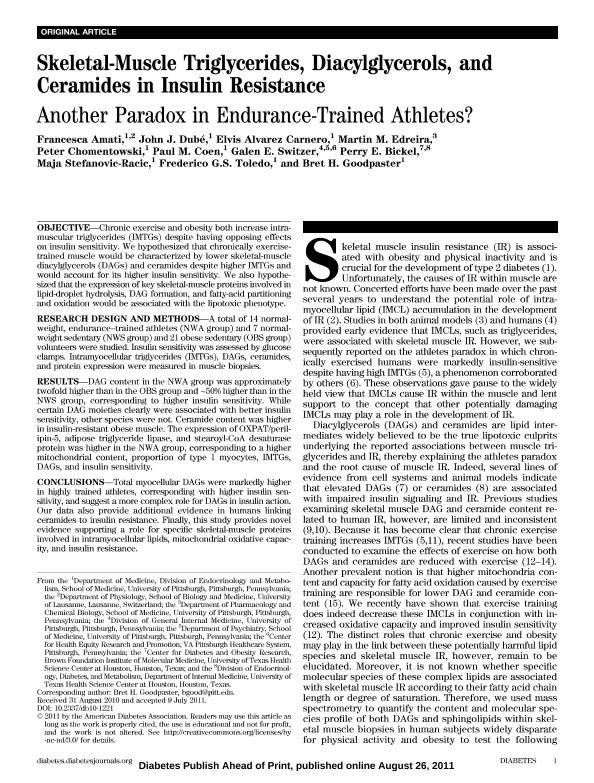Mostrar el registro sencillo del ítem
dc.contributor.author
Amati, Francesca
dc.contributor.author
Dubé, John J.
dc.contributor.author
Alvarez Carnero, Elvis
dc.contributor.author
Edreira, Martin Miguel

dc.contributor.author
Chomentowski, Peter
dc.contributor.author
Coen, Paul M.
dc.contributor.author
Switzer, Galen E.
dc.contributor.author
Bickel, Perry E.
dc.contributor.author
Stefanovic Racic, Maja
dc.contributor.author
Toledo, Frederico G. S.
dc.contributor.author
Goodpaster, Bret H.
dc.date.available
2019-07-11T20:32:33Z
dc.date.issued
2011-10
dc.identifier.citation
Amati, Francesca; Dubé, John J.; Alvarez Carnero, Elvis; Edreira, Martin Miguel; Chomentowski, Peter; et al.; Skeletal muscle triglycerides, diacylglycerols, and ceramides in insulin resistance: Another paradox in endurance-trained athletes?; American Diabetes Association; Diabetes; 60; 10; 10-2011; 2588-2597
dc.identifier.issn
0012-1797
dc.identifier.uri
http://hdl.handle.net/11336/79425
dc.description.abstract
OBJECTIVE - Chronic exercise and obesity both increase intramyocellular triglycerides (IMTGs) despite having opposing effects on insulin sensitivity. We hypothesized that chronically exercisetrained muscle would be characterized by lower skeletal muscle diacylglycerols (DAGs) and ceramides despite higher IMTGs and would account for its higher insulin sensitivity. We also hypothesized that the expression of key skeletal muscle proteins involved in lipid droplet hydrolysis, DAG formation, and fatty-acid partitioning and oxidation would be associated with the lipotoxic phenotype. RESEARCH DESIGN AND METHODS - A total of 14 normalweight, endurance-trained athletes (NWA group) and 7 normalweight sedentary (NWS group) and 21 obese sedentary (OBS group) volunteers were studied. Insulin sensitivity was assessed by glucose clamps. IMTGs, DAGs, ceramides, and protein expression were measured in muscle biopsies. RESULTS - DAG content in the NWA group was approximately twofold higher than in the OBS group and ~50% higher than in the NWS group, corresponding to higher insulin sensitivity. While certain DAG moieties clearly were associated with better insulin sensitivity, other species were not. Ceramide content was higher in insulin-resistant obese muscle. The expression of OXPAT/ perilipin-5, adipose triglyceride lipase, and stearoyl-CoA desaturase protein was higher in the NWA group, corresponding to a higher mitochondrial content, proportion of type 1 myocytes, IMTGs, DAGs, and insulin sensitivity. CONCLUSIONS - Total myocellular DAGs were markedly higher in highly trained athletes, corresponding with higher insulin sensitivity, and suggest a more complex role for DAGs in insulin action. Our data also provide additional evidence in humans linking ceramides to insulin resistance. Finally, this study provides novel evidence supporting a role for specific skeletal muscle proteins involved in intramyocellular lipids, mitochondrial oxidative capacity, and insulin resistance.
dc.format
application/pdf
dc.language.iso
eng
dc.publisher
American Diabetes Association

dc.rights
info:eu-repo/semantics/openAccess
dc.rights.uri
https://creativecommons.org/licenses/by-nc-sa/2.5/ar/
dc.subject
Triglycerides
dc.subject
Diacylglycerols
dc.subject
Ceramides
dc.subject
Insulin Resistance
dc.subject.classification
Medicina Critica y de Emergencia

dc.subject.classification
Medicina Clínica

dc.subject.classification
CIENCIAS MÉDICAS Y DE LA SALUD

dc.title
Skeletal muscle triglycerides, diacylglycerols, and ceramides in insulin resistance: Another paradox in endurance-trained athletes?
dc.type
info:eu-repo/semantics/article
dc.type
info:ar-repo/semantics/artículo
dc.type
info:eu-repo/semantics/publishedVersion
dc.date.updated
2019-07-10T19:04:17Z
dc.journal.volume
60
dc.journal.number
10
dc.journal.pagination
2588-2597
dc.journal.pais
Estados Unidos

dc.journal.ciudad
Nueva York
dc.description.fil
Fil: Amati, Francesca. University of Pittsburgh; Estados Unidos. Universite de Lausanne; Suiza
dc.description.fil
Fil: Dubé, John J.. University of Pittsburgh; Estados Unidos
dc.description.fil
Fil: Alvarez Carnero, Elvis. University of Pittsburgh; Estados Unidos
dc.description.fil
Fil: Edreira, Martin Miguel. University of Pittsburgh; Estados Unidos. Consejo Nacional de Investigaciones Científicas y Técnicas. Instituto de Investigaciones en Ingeniería Genética y Biología Molecular "Dr. Héctor N. Torres"; Argentina
dc.description.fil
Fil: Chomentowski, Peter. University of Pittsburgh; Estados Unidos
dc.description.fil
Fil: Coen, Paul M.. University of Pittsburgh; Estados Unidos
dc.description.fil
Fil: Switzer, Galen E.. University of Pittsburgh; Estados Unidos. Center for Health Equity Research and Promotion; Estados Unidos
dc.description.fil
Fil: Bickel, Perry E.. University of Texas Health Science Center at Houston; Estados Unidos
dc.description.fil
Fil: Stefanovic Racic, Maja. University of Pittsburgh; Estados Unidos
dc.description.fil
Fil: Toledo, Frederico G. S.. University of Pittsburgh; Estados Unidos
dc.description.fil
Fil: Goodpaster, Bret H.. University of Pittsburgh; Estados Unidos
dc.journal.title
Diabetes

dc.relation.alternativeid
info:eu-repo/semantics/altIdentifier/url/https://www.ncbi.nlm.nih.gov/pmc/articles/pmid/21873552/
dc.relation.alternativeid
info:eu-repo/semantics/altIdentifier/doi/http://dx.doi.org/10.2337/db10-1221
dc.relation.alternativeid
info:eu-repo/semantics/altIdentifier/url/https://diabetes.diabetesjournals.org/content/60/10/2588
Archivos asociados
